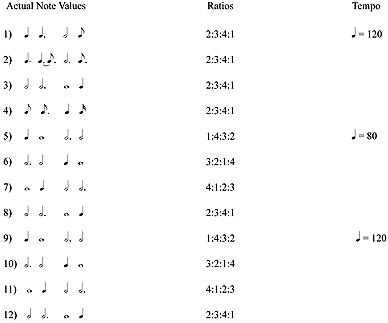Purloined Too
in memoriam Sylvia
but also in celebration of a 90th birthday
subtext: When Shall We Three Meet Again
This text follows “Purloined Rhythms”1, which discussed the matter of hidden, perchance notationally distorted, rhythmic trajectories.
Consider the following:
(ex.1)

What is the underlying rhythmic pattern?
Footnotes
Calculating durations from attack to attack2 we find:
(ex. 2)
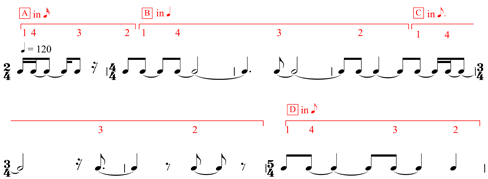
These 7 measures contain 4 groups (brackets ![]() ,
, ![]() ,
, ![]() ,
, ![]() ) of 4 attacks each. The form, or shape, within each bracket, has the rhythmic ratio of 1:4:3:2 parts, so that, for bracket
) of 4 attacks each. The form, or shape, within each bracket, has the rhythmic ratio of 1:4:3:2 parts, so that, for bracket ![]() , the initial duration is 1
, the initial duration is 1 ![]() , followed by a duration of 4
, followed by a duration of 4 ![]() , followed by a duration of 3
, followed by a duration of 3 ![]() , followed by a duration of 2
, followed by a duration of 2 ![]() . Each subsequent bracket repeats the ratio-pattern 1:4:3:2, but at a different rate of speed, the rates and order of the speeds being determined by the progression of the underlying ratio. In other words, given that the unit-rate of bracket
. Each subsequent bracket repeats the ratio-pattern 1:4:3:2, but at a different rate of speed, the rates and order of the speeds being determined by the progression of the underlying ratio. In other words, given that the unit-rate of bracket ![]() is
is ![]() ; the unit-rate of
; the unit-rate of ![]() is therefore 4 times that of
is therefore 4 times that of ![]() =
= ![]() ; the unit-rate of
; the unit-rate of ![]() is 3 times that of
is 3 times that of ![]() =
= ![]() ; and 2 times
; and 2 times ![]() , or
, or ![]() , is used for
, is used for ![]() . Thus, the ratio-pattern 1:4:3:2 determines both the rhythmic progression within each bracket (the “micro” level) as well as at a larger, or more “macro,” level.
. Thus, the ratio-pattern 1:4:3:2 determines both the rhythmic progression within each bracket (the “micro” level) as well as at a larger, or more “macro,” level.
(Ex. 3) superimposes the 4 groups of 4 attacks, showing the Canonical Form of the same pattern of ratios at the four different rates of speed.
| (ex. 3) | 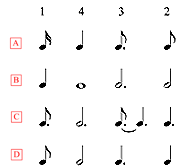 |
If ever anything was “hidden in plain sight”, (ex.1) is “it”!
What, then, of (ex.4)?
(ex. 4)
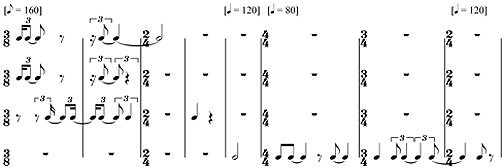
That there is more Four Play of 4 groups of 4 attacks each, each group having the rhythmic form (or ratio) of 1:4:3:2 parts is fairly obvious.
But is it so obvious that not only are (exs. 1 & 4) of similar form, but are (in terms of attack to attack) durationally IDENTICAL? Evidence for this may be found later amongst the Glosses, but first find your own solution!
-
"Rest" durations are added to the duration of the previously sounding note
(Ex.s) 5, 6, and 7 present further “purloined”3 samples.
(ex. 5a)

(ex. 5b)

(ex. 6a)

(ex. 6b)

(ex. 7a)

(ex. 7b)

(ex 7c)

For (ex. 5 a & b) the ratios are 4:1:2:3; for (ex. 6 a & b) they are 2:3:4;1; and for (ex. 7 a, b & c) 3:2:1:4 (and I again urge you to do your own pre-Partitions before consulting the later-day Paraphrases).
These examples all represent puzzles quite cute, but of what import? Why so elevate this opacity? Why belabor these poor ratios?
One answer is that these particular rhythmic ratios permeate the Composition from whence they emanate, and to understand the Relata of this work, one must confront these ratios. Another answer is that similar usage saturates Tutte Le Corde of the composer of our examples. Most importantly, the desire for temporally transposed rhythmic ratios is the Generatrix of a Bicenguinguagenary Fanfare of problems to be found in scores of scores, if not hundreds of scores, composed by at least An Elizabethan Sextette, if not a Consortini, of different composers.
-
In the adapted meaning as defined towards the end of "Purloined Rhythms".
This is because composers have always been fascinated by, and have always required, that identical musical interrelationships occur simultaneously at multiple speeds. The above examples do not represent a conceptual problem; they represent a notational one, caused by the fact that our present system of rhythmic notation gives precedence to the more-or-less precise vertical alignment of multiple parts, while subjugating and minimizing the appearance-of-form of a rhythmic motive scaled over different total durations; and this forces the notator of the musical idea to distort the natural contour of a rhythm in favor of cramming it into a rather inflexible vertical grid4. Furthermore, in this particular instance, the composer wants the same ratio-pattern repeated at multiples OTHER than the duple, and for that, our present system of rhythmic notation is especially recalcitrant.
But before we Swan Song into, or proceed Around the Horn with, the notational irritants, let us detour into less Beaten Paths, and briefly discuss the meaning and implications behind these ratio-patterns.
(Ex. 3) displayed the simplest form(s) of 1:4:3:2, as used in (ex.1) , but (exs. 5,6, & 7) showed different arrangements, or orderings, of the internal numbers.
(Ex. 8 ) provides, for one tempo, all 4 utilized ratio patterns superimposed upon each other, spaced as if they were written in ![]() (the units 1+2+3+4 = 10).
(the units 1+2+3+4 = 10).
| (ex. 8) | 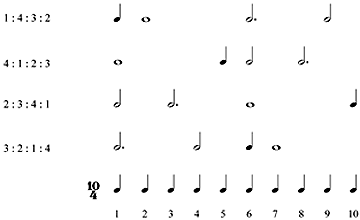 |
- This is not just a (historical) musical-notation problem. The statistician John Tukey and the now snubbed proto-mathematical biologist D’Arcy Thompson (as well as Julian Huxley) had much the same implied plaint regarding their data vs. square (Cartesian) grids!
These ratios are NOT just Virginal, Bookish, theoretical constructs. The component numbers represent durations, and/or weights; and as the components occur in specific orderings, order and duration/weight combine to form distinct musical shapes which possess directed motion.
For example, the pattern 1:4:3:2 might be thought of as having an upbeat to the longest note, with everything sloping faster thereafter; whereas 4:1:2:3 starts with the longest note, drops to the shortest, but thereafter has a succession of increasing durations. The pattern 2:3:4:1 begins with a series of elongating values, whereas 3:2:1:4 accelerates until it arrives at the longest and final note. Put another way, two of the patterns might be said to accelerate, whereas the other two might be said to decelerate; and both accels. and decels. occur over two time-spans i.e. 9 and 6 ![]() respectively, which can be seen in (ex. 9) where the faint dashed blue arrows slanted up-or-downwards indicate accel or decel.5
respectively, which can be seen in (ex. 9) where the faint dashed blue arrows slanted up-or-downwards indicate accel or decel.5
(ex. 9)
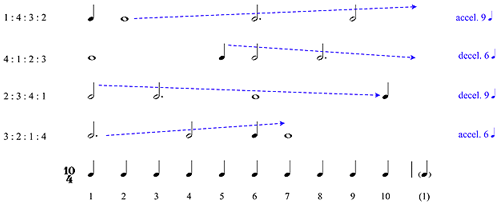
- Observe that every two-note pattern on the left side of the matrix (i.e. 1st through 5th
 ) is also to be found on the right (6th through 10th
) is also to be found on the right (6th through 10th  ), albeit on a different line. The learning problem can therefore possibly be reduced to that of the 4 two-note patterns on the left of (ex. 8), each of which sums to 5 units, each with a “lilt” or “limp” different from that of the others (also see the Table of Quintuplet Partitions)(Ex. 8) further demonstrates that the combined rhythm of all four ratio-patterns provides an attack on every one of the 10
), albeit on a different line. The learning problem can therefore possibly be reduced to that of the 4 two-note patterns on the left of (ex. 8), each of which sums to 5 units, each with a “lilt” or “limp” different from that of the others (also see the Table of Quintuplet Partitions)(Ex. 8) further demonstrates that the combined rhythm of all four ratio-patterns provides an attack on every one of the 10  . This, plus the pervasive use of 5 (somewhat akin to the “curious incident of the dog in the night-time”) may prove a useful hint for those sections of the composition where the ratios are rather more hidden.
. This, plus the pervasive use of 5 (somewhat akin to the “curious incident of the dog in the night-time”) may prove a useful hint for those sections of the composition where the ratios are rather more hidden.
Even when hummed in a monotone (not to say a Melismata), the differences of these rhythmic trajectories are instantly manifest, and their fundamental shapes may very well not appear if all that one is thinking (when playing) is the accurate placement of a succession of seemingly arbitrary durations, with equally-seeming arbitrary Arrivals and Departures.
Now I do not propose, every time one encounters one of these patterns, the superimposition of, and overindulgence in, an accelerando or a ritard. I only posit that these patterns have trajectories; and these trajectories should be thought about; occasionally acknowledged; sometimes even “leaned into”6.
But what may we say about maintaining a single ratio-shape, across four different tempi?
Here two problems, of quite different natures, arise. One problem is that it is not a given that a temporal ratio, when performed at a substantially different tempo, is perceived by the listener, or even the performer, as being the same; and in order to ensure that a pattern-shape is so perceived, it may well be that, for different tempi, subtle differences in the nominal ratios are required. More concretely, (ex. 2/![]() ), must probably be produced with somewhat different emphasis, and with slight changes in the precise ratios, so as to be perceived as being the “same” as
), must probably be produced with somewhat different emphasis, and with slight changes in the precise ratios, so as to be perceived as being the “same” as ![]() , but much slower. This fundamental facet About Time is fascinating, but (sadly) is beyond the scope of this text7.
, but much slower. This fundamental facet About Time is fascinating, but (sadly) is beyond the scope of this text7.
The second problem (purportedly of less import) concerns the machinations required to notate non-duple temporal transpositions. It is the composer’s inability (due to the notational stylistic restrictions of the time) to discretely notate non-duple parts of a beat or bar, that gives rise to the purportedly competing, but actually complementary, metronome markings of ![]() vs.
vs. ![]() .8 The concomitant arithmetic is mildly irritating, easily dispatched, and is sketched later.
.8 The concomitant arithmetic is mildly irritating, easily dispatched, and is sketched later.
But the overall notational aspect is not to be too easily dismissed, for it encapsulates the entire matter of the psychology of music notation -- i.e. what is the performer to make of rhythmic segments so disparate in their notation, but (nominally) temporally identical? If a passage could be written in the same way, why not do so? What meaning are we to ascribe to these Correspondences? Are they only Occasional Variations? What reason or function do these Transfigured Notes serve? Have they been forced upon the composer by constraints? If so, what constraints, and are they dispositive? Are pitch-classes (My Complements to Roger, and may I say melodic contours?) responsible? Interval content? The desire for loudness changes contradicting metric stress? Or are the transformations a simple case of Play It Again, Sam, BUT DIFFERENTLY? But what of the Dual that may be implied by related patterns differently falling willy-nilly upon impaling barlines? Were the meters chosen a-priori, and therefore the rhythmic notation must play “second fiddle”? If yes, how does one recognize that hierarchy? More pragmatically, how does one convey it? Can one convey both the similarity of the isorhythm, plus the stress-differences implied?9 If yes, how? If not, why utilize such rhythmic differences?10 Are the renotations unintentional? Arbitrary? Was the composer being Donnishly clever? Or rather, with malice aforethought, creating a window for Schadenfreude? Was the composer deliberately disguising the innate classicism of the recapitulative construction? Or are these notational conundrums naught but a musical manifestation of this composer’s pen-chant for puns? And finally, and in some high dudgeon, is not the playing of the damn-anded frequency at the required time, a sufficiency? MUST our Philomel also be forced to think Overtime?
All these, and many many others, are Reflections that it is the absolute responsibility of the performer to wonder about, to wander within!
But the answers to these concerns are not immutably All Set. One is only given the opportunity to pose Cultivated Choruses which “may” help guide one to rational, if nevertheless arbitrary, and almost indubitably, temporary solutions i.e., the process that used to be implied by the word “interpretation”.
But how can anyone, in good faith, in such an arithmetical and purportedly precise context, even utter that dreggish word into The (already overly) Crowded Air?
Untold years ago there were (and still may be) THOSE who held categorical the fact that, in 20th Century music, the excessive notational detail -- of rhythm, of articulation, of dynamics, tempo, you-name-it -- prevented any possibility for human interaction; one needed not a human performer; one needed only a performing machine.
I wished THOSE types Into the Good Ground then, and do so still. My Tableaux is simple:
no matter the subject, no matter the raiment it may assume;
the more complicated or detailed any text;
the more the minutia;
the greater the chance for one detail to conflict with another, for one minutia to countervail some other;
and these conflicts cry out for resolution -- and this Phonemena is not restricted only to the notation of music.
It is a universal.
The need for guidance; the need to cut through the thickets so as to bring out those aspects that one feels salient, that one wishes to draw attention to -- that need is overwhelming; and nothing could be truer than when performing 20th-century music. Forfend the oleaginous pre-K T-boundary Bronte-Tsuris-like approach that ooooooozes all before it! Perhaps 20th-century music does have somewhat less interpretive leeway than 19th- century music11, but even IF (and that is a large if) the music of the recent past is, on the surface, more detailed, more explicit, and therefore has an appearance of greater restriction, the attempt to purportedly accurately convey that detail does not exempt the performer from the myriads of textual and interpretative decisions that must be made if one is to have a Prayer of presenting a coherent Vision.
Now if purported temporal “accuracy” only (where one is perhaps merely Playing for Time?) can be a fool’s errand, as such accuracy alone may not provide the perceived rhythmic shapes we need to enhance our understanding, what can we do to bring ourselves closer to the “felt necessities” of the composition?12
As always, an entree to a text whose visage is fearsome, but whose reality is not, may be through experiments with the notation.
“Toute brisure d’écriture a la forme d’une clé...”13 is not far from the truth. Competing notations allow one to envisage multiple facets of the same work. Note that a Little Goes a Long Way. Little will be gained by renotating to such an extent that the original is No Longer Very Clear. The composer had valid reasons to chose the chosen notation, and I do not command that The Old Order Changeth. I do, however, suggest that a succession of fresh Images will change how the old order is perceived, and may allow one to better glimpse the Manifold Music whose spirit resides somewhere within the interstices of competing notational possibilities.
For the rigid, who crab at the nominal violation of the composer’s notation, I exhort that, as with “Nomina sunt consequentiam rerum” 14, so too is musical notation the afterthought of an underlying musical idea. Therefore, be Groupwise,
see thru the fog of notation
determine what constitutes The Head of the Bed
and allow the notationally unseen to Psalter to the top.
- The hypothesis is that one must “shape” the pattern so that a listener may perceive it as such. The red-line that should never, ever be crossed is to so excessively “shape” the pattern that a perceiver probably hears it as something “other”. We leave in abeyance the question of how “shaping” may affect the ratio relations of bracket to bracket, noting only that our perceptual abilities in comparing temporal segments larger than some arguable threshold are not as acute as those when comparing shorter temporal units that are in close proximity.
- While knowledge of the precise msec. adjustments needed to maintain perceived form is indeed desirable and fascinating, it may not necessarily be helpful or useful; and it is not entirely Cavalier to suggest that one can allow one’s “ear” to help decide if, at different speeds, the perceived shapes are comparable. Here is a clear instance where (In His Own Words) Who Cares If You Listen, can not, must not, apply!
- More recently, the composer has instead utilized compound time signatures such as
 , thereby avoiding some (while introducing other) notational complications.
, thereby avoiding some (while introducing other) notational complications. - Stress changes (if any) would be due to “where” things occur relative to a purportedly functional meter, a question as applicable to today’s music as it is to much earlier music. However, before one decides to change stresses within the ratio-patterns, one must determine if those patterns are imposed upon the meters, or if the reverse is closer to the truth. On the one hand, this particular composer has stated to me that the matter of whether or not a recent composition uses constant or changing meters (which obviously determines barline placement) is not a salient issue, but is determined by the wishes of the performer for whom the work is being written; on the other hand, changing meters is clearly a significant part of the composition under consideration, and is manifestly responsible for many additional notational complications -- therefore, one may only ignore the meter changes after due deliberation and reflection. On the third hand (which probably should be the first), how one conveys, without gaudy prodigal contortion, BOTH metric stress as well as the ratio-pattern, especially when confronted with sustained, steady-state, tied durations that take place over barlines, is, at the clearest, a “riddle, wrapped in a mystery, inside an enigma”.
- By “rhythmic differences”, I do not refer to notational variants required for articulative change i.e. two identical metric placements, one utilizing short duration notes plus rests; the other longer, more sustained, values.
- Although the interpretation of that is almost equally circumscribed by what is presumed to be style, sometimes referred to as “tradition - schlump-erei”; or in the words of Lewis Carroll "The style is that which is usually known as 'Early Debase': very early, and remarkably debased." (The New Belfrey of Christ Church, Oxford)
- The foregoing is not an attack on the attempt at accuracy. That attempt is a necessary, but far from sufficient, condition. Musicians, and their audience, can not live by accuracy alone. Accuracy (from a Latin root meaning prepared with care) is an aspect quite different from the imbuement and conveyance of meaning. Accuracy alone allows for neither L’Allegro or Il Penseroso. As analogy: a restaurant that accurately prepares my meal is probably not a restaurant I shall frequent, and certainly not with Joy, with or without Sextets.
- “All shattered writing has the form of a key...” Edmond Jabès; “The Book of Questions - EL, or the Last Book (Gallimard/Wesleyan)
- “names are sequent to the things named”.
Arie da Capo & Counterparts
I began this Solo Requiem with rhythmic motives in the ratio 1:4:3:2, at four tempi (ex.s 1 & 2). I then stated that (ex. 4) followed that same pattern.
(Ex. 10) demonstrates that.
(ex. 10)
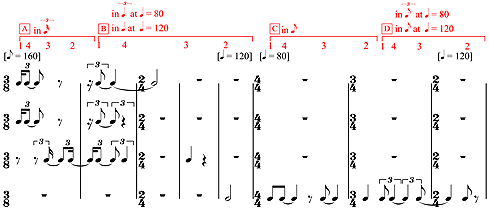
(Click on image for enlarged version)
I also stated that not only were (ex.s 1 & 4) “of similar form, but are (in terms of attack to attack) durationally IDENTICAL! “.
(Ex. 11) demonstrates that.
(ex. 11)

(Click on image for enlarged version)
The critical point to remember is that the ![]() at
at ![]() = the
= the ![]() at
at ![]() (i.e. 4 X MM 120 = MM 480; 6 X MM 80 = MM 480).
(i.e. 4 X MM 120 = MM 480; 6 X MM 80 = MM 480).
This common value of MM 480 appears (in (ex.11)) as a “tactus” of constant ![]() notes, placed between (ex. 1) (the line above the “tactus”), and a single-line composite of all of the attacks of (ex.s 4 &10) (the line below the “tactus”). In segment
notes, placed between (ex. 1) (the line above the “tactus”), and a single-line composite of all of the attacks of (ex.s 4 &10) (the line below the “tactus”). In segment ![]() the “tactae” are beamed so as to show the grouping of 1:4:3:2, which corresponds to the ratio in question. Note that for every interattack value (i.e. the duration from one attack to the next) above the “tactus” line there is an interattack value below that, no matter how different the outward appearance, corresponds precisely to the number of “tactae” used for the upper line.
the “tactae” are beamed so as to show the grouping of 1:4:3:2, which corresponds to the ratio in question. Note that for every interattack value (i.e. the duration from one attack to the next) above the “tactus” line there is an interattack value below that, no matter how different the outward appearance, corresponds precisely to the number of “tactae” used for the upper line.
In segments ![]() ,
, ![]() , and
, and ![]() the “tactae” have been sub-beamed so as to show both the 1:4:3:2 pattern, as well as the changes in the base units. Once again, the number of “tactae” corresponds above and below, and the outer two lines (ex.s 1 & 4) are therefore durationally identical 15.
the “tactae” have been sub-beamed so as to show both the 1:4:3:2 pattern, as well as the changes in the base units. Once again, the number of “tactae” corresponds above and below, and the outer two lines (ex.s 1 & 4) are therefore durationally identical 15.
For further clarification, (ex.12) recapitulates (ex.3),
| (ex. 12) | 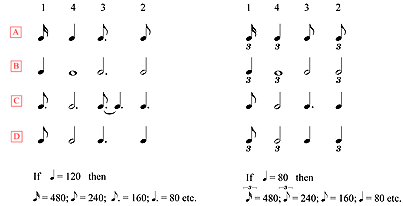 |
In the above example, what was (ex.3) is now at the left; the corresponding values of (ex.s 4 & 11) are at the right. Reminders of some basic arithmetic are beneath.
(Ex.s 13, 14 & 15) present red-bracketed versions of (ex.s 5, 6 & 7)(respectively) .
(ex. 13a)

(ex. 13b)
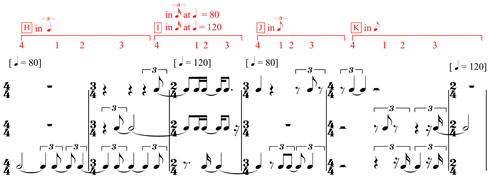
(ex. 14a)
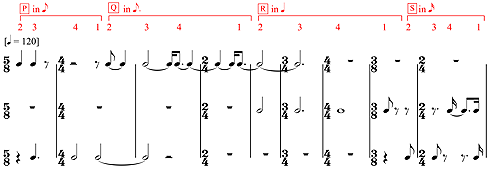
(ex. 14b)

(ex. 15a)

(ex. 15b)

(ex. 15c)

(Ex.s 13, 14 & 15) confirm previous statements regarding ratios used; but more importantly, they can be used to discuss whether or not the different samples of similar patterns are, or are not, temporally identical attack to attack, as was the case with (Ex.s 1 & 4). If they are, one can then proceed to a discussion of the Soli e Duettini nature of the notation.
- To further explore the renotation of identical rhythmic durations, consult the original score, comparing the section starting meas. 43 vs. the section starting meas. 172; and (a much simpler example) starting meas. 89 vs. 280. Do this both to see for how long one can trace the identities, and to marvel at the thoroughness of the disguise.
Enjoy working thru these Emblems!16
At this point, someone is certain to ask, “could not the composer have written all this in some other (simpler) fashion? Why not utilize only one time-signature, such as a Minute Waltz (or 3/4 - 1/8), in other words, ![]() or
or ![]() , so that the time-signatures better correspond to the 10 parts (5 + 5) of the rhythmic motive? Or could less metric modulation have been used; or what about a notation closer to that of (ex. 3) or, or?”
, so that the time-signatures better correspond to the 10 parts (5 + 5) of the rhythmic motive? Or could less metric modulation have been used; or what about a notation closer to that of (ex. 3) or, or?”
Omitting the matter of the composer’s personal preferences, the answer is -- perhaps, yes; but every possible rewrite comes with its own set of vagaries, inconsistencies and/or horrors. In this and similar music, all possible notations will wobble amongst at least the following constantly competing objectives viz: (a) the attempt to preserve the outward (written) form of the ratio so that it is more easily recognized; (b) the need to maximize the accuracy of the relations between the different tempi at which the ratios appear; and (c) the ability to allow for the precise juxtaposition (across different parts) of different starting points; and it is the responsibility of the performer to not confuse perforce notational deformations and distortions with the intrinsic impetus.
No matter the notation, every text requires interpretation, translation, and conveyance; and to better understand this Ars Combinatoria, consider the following.
Envoi
(Ex. 16) presents the peroration of our composition.
(ex. 16)
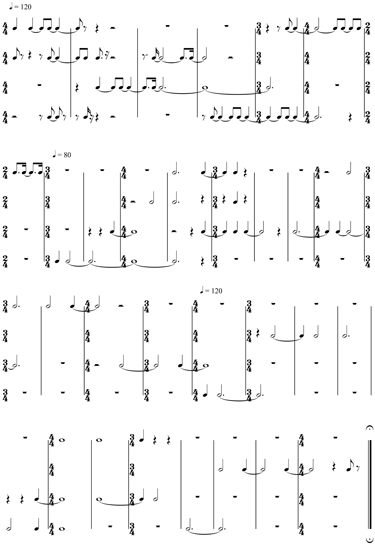
Du may consult (ex. 17), which shows that these final 31 measures contain 12 presentations of our ratio groups.
| (ex. 17) |
- “Emblem reduceth conceits intellectual to images sensible, which strike the memory more; out of which axioms may be drawn much better practice than that in use...”Bacon, Advancement of Learning.
These 12 presentations reduce to 3 large sections,17 the first consisting of one ratio-pattern at 4 speeds; the second section being all four ratio-patterns at 1 speed; the third section being a repeat of the second section, but quicker.
This could perhaps be more clearly notated as in (ex. 18).
(ex.18)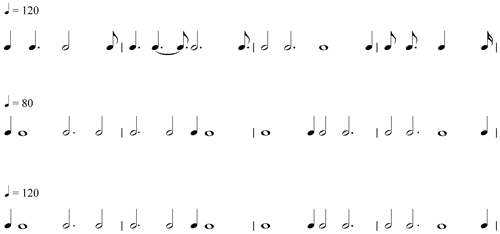
Suddenly, the rhythm of this peroration assumes a Semi-Simple musical shape that is not at all as syncopated, agita(to)-causing as (ex. 16 ) might have led one to believe.
- of 25 : 40 : 40
 ; or 12.5 : 30 : 20 seconds, respectively. These large durations are in the ratio of 5 : 12 : 8, which may, or may not, prove helpful in disrobing the quincunx?
; or 12.5 : 30 : 20 seconds, respectively. These large durations are in the ratio of 5 : 12 : 8, which may, or may not, prove helpful in disrobing the quincunx?
Never forget that notation shapes the way we think, and determines what we can think about18.
Performers who only see and play the notated Accompanied Recitative (or Theatrical Songs?) of (ex.16) will probably jaggedly perform a series of small syncopations. The overall line may be unarticulated, but underneath the surface smoothness will be a disquietude that may, or may not, be intended, or intentional. To the contrary, performers who see, internalize and play the notation of (ex. 18), will perform that same collection of rhythms in an entirely different fashion, possibly with greater quiescence, perhaps even consopiation, and will without doubt emphasize entirely other musical aspects19.
And this gives rise to a Widow’s Lament, and a Homily.
Lament: even tho I have, especially over the years, spent some time with this work, these ratios, and these last measures, the fact is that to this day the contour of (ex. 18) still does not “leap off the page” to me when notated as in (ex. 16). I know that the patterns are there. I know that they exist; but my mind’s eye SEES THEM NOT!
(unless I have re-barred the score).
Homily: one can not expect to intelligently perform this work without knowing these patterns, and their usage. The notation of (ex. 16), as well as all our other examples, requires that time be spent doing the numbers. Sheer Pluck will not see you thru.
DO YOUR WOODSHEDDING!
And having presented, at an overly generous length, our Preludes and Interludes, here followeth the Postlude.
For Lagniappe, consider (ex 19).
| (ex. 19) | 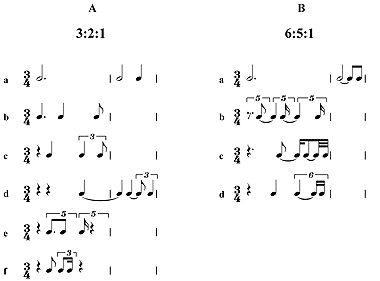 |
- A paraphrase of Benjamin Lee Whorf: “Language shapes the way we think, and determines what we can think about”.
- and this applies to all of our re-notated examples.
These are Piccolino presentations of two different ratios (col. (A) = 3:2:1; col. (B) = 6:5:1). The single presentations better allow us to understand that the shape deformations are a function of two factors: (a) where the pattern begins; and (b) the total time over which the pattern is splayed; and these factors may be combined in an infinitude of possibilities. To say It Takes Twelve to Tango is a gross underestimate!20
Given the myriad possibilities, how is None but the Lonely Flute to recognize these disparate Sonnets as avatars of a single, fundamental unity?
There is no single simple answer, but be especially suspicious of a plethora of syncopations. The “beat” in this music is fairly joyously “irrelephant”; the meter perhaps even more so, certainly on an acoustic level. A notated series of dyspeptic syncopations (such as ex. 19 Col. A letter d; or col.B letter b) most probably does not have that meaning. That is a visage assumed because of various constraints; and the conventions and restrictions that force the constant re-jiggerring of the motive are not an excuse to deem the motive changed.
Rather, it is imperative that the integrity of the ratio be maintained!
Finally (Laus Deo), as My Ends are My Beginnings, I present, as a Whirled Series,
- It is not surprising that a pattern, splayed over different temporal spans, will have an altered appearance. More surprising is the extent of change that occurs if one only shifts the starting point while maintaining the same temporal space (i.e. imagine (ex. 19) col.A #1 shifted to the right by an
 , or
, or  , let alone by a triplet, or quintuplet). Writing out some of the many possibilities that result from combining different starting points with different spans is a worthwhile classroom assignment that can be continued well beyond one’s heart’s content.
, let alone by a triplet, or quintuplet). Writing out some of the many possibilities that result from combining different starting points with different spans is a worthwhile classroom assignment that can be continued well beyond one’s heart’s content.
Canons
TO LIVE BY!
Notation distorts as often as it clarifies!
The style of the notation dramatically affects how you view, perceive and understand the text.
Intent (to the extent that you can divine it) always trumps notation.
Do not mistake the written notation for the actuality of the rhythmic trajectory, and for the impetus of the motive.
A change in the notation does NOT necessarily imply a change in the impetus, thrust and/or trajectory of the pattern.
Look for patterns that may not be/ARE NOT, related to the nominal time-signature. Also, a pattern not evenly divisible by or within the time-signature almost always assumes a misleading appearance; and that can be especially true for constant values.
“Do not go gentle into that” benighted night of blindly playing only what you are presented. Rather, renotate, re-express your pattern(s). Wade thru the competing notational possibilities. Play the essence behind the ratios. Characterize the motive, as you might a personage in an opera, or in a play.
And never forget that, for all of our endless Ensembles of Septet, But Equal questions and doubts, as the non-delayed Dorothy once said: “If we walk far enough I am sure we shall sometime come to some place”.
Paul Zukofsky
“May 10”, 2006
Bangkok, Singapore, Bangkok, Hong Kong21
- Rhythmic examples 1 - 18 are extracted from Milton Byron Babbitt’s Composition for Four Instruments (1948).
The data are as follows:
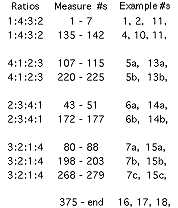
(Ex. 19) originates in The Crowded Air (1988), as distilled in, and purloined from, Andrew Mead’s “Introduction”.
With two exceptions, Words in Italics are titles of compositions by MBB. I am indebted to U.S. v. Syufy Enterprises, for the thought of using, within the article, as many MBB titles as possible. Howard Stokar’s list of MBB Compositions was of inestimable help, and it is my pleasure to acknowledge same. It seemed puerile to overly include generic titles such as Concerto, etc. etc. As an act of filial piety, some works with texts by authors “prohibitorum et expurgatorum” have been omitted.
In regards the two non-composition-title exceptions, one is the title of a(n) (in)famous article by MBB. The other is a calembour resulting from the simultaneity of: (a) the viewing, with a very young granddaughter, of the Laurence Olivier film of “Wuthering Heights”; (b) the asking by said granddaughter as to what it all meant; and (c) the knowledge that the granddaughter had a passion (it is to be hoped equally unrequited) for dinosaurs. The resultant amphibiology Bronte-Tsuris is the perfect representative of MBB’s compositions -- deep knowledge, learning and awareness, combined with an over-heightenned desire to be obliging, plus sweet & sour humor, of a very light touch.
There are also embedded highly inside teases and references, the accretions of working together, squabbling, arguing the merits (and more numerous deficits) of certain Chinese restaurants, “Magritte”-like moments re Triads, and in general, playing within the same sandbox, lo(!) these past 50 years.
